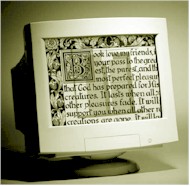
Two years ago, Ipsos Book Trends, a company that studies consumer buying patterns, added used books to the list of goods the company tracks. The first report shocked many in the publishing industry—consumers purchased more than 100 million used books worth half a billion dollars. More importantly, Ipsos estimated that those used book purchases displaced at least $1 billion in new book sales. Its second report, covering 2003, showed that the used market had grown, and while the total number of new and used books sold increased slightly, the dollars spent on all books fell. Ipsos concluded that this trend—more books sold for less money—was at least “partially explained by continuous increases in used book buying. ”
The Book Industry Study Group, a not-for-profit research institute, came to a similar conclusion: new book sales are declining. Albert Greco, a business professor at Fordham University and a consultant to the industry, said, “We believe this is due to a variety of factors, the biggest being the used book market. ” More proof of the strength of the used book market comes from the National Association of College Stores, whose members sold $1. 6 billion in used books and textbooks during the 200102 academic year. Used books generated nearly one-third of total book sales and were the stores’ most profitable product line after school logo items.
Susan and David Siegel, co-owners of Book Hunter Press and publisher of the Used Book Lover’s Guides, announced in May the results of a used bookseller survey.
More than 800 dealers participated, and their responses offer an unprecedented look at the core of the book trade. Susan Siegel defines the core as everyone from part-time, Internet-only operations to the largest used bookstores. Her definition does not include “penny sellers, true antiquarians or paperback exchanges. ” It also does not include the informal book trade—library and garage sales and individuals selling exclusively on Amazon’s used-merchandise “Marketplace” and eBay.
The study demonstrated that traditional used bookstores still account for 80 percent of core used book sales, even though the shops rely more and more on the Internet for customers. According to the Siegels’ research, more than half of all sales (by dollar value) originate from Internet venues. Sales in open shops plummeted to under 30 percent of the total in 2003.
As the core market reorganized, it also declined, with revenues from used books dropping 8 percent between 2001 and 2003. Susan Siegel doesn’t think that the market as a whole is shrinking. Rather, the core appears to be getting smaller.
The moribund core may be the result of an exploding informal market for used books. No precise figures are publicly available, but circumstantial evidence suggests that eBay and Amazon, where anyone can sell used books, have encouraged a large and growing group of customers to cut out the middle man—the professional bookseller—in favor of buying and selling among individuals.
In 2004, eBay expects $2. 4 billion in sales from its books, music and movies category, which includes vinyl records, tapes, CDs, DVDs and VHS cassettes as well as books.
Typically, more book auctions occur annually than of music or movies leading to more high-dollar sales. Taking a reasonable estimate (eBay declined to provide detailed figures) that books are one-third of the category, eBay generates $800 million per year in used book sales, 25 percent more than the roughly 8000 core booksellers. Amazon does not report used book sales either. However, that segment is thought to produce more than one fourth of total book sales and a significant proportion of the site’s profits.
Used book sales on Amazon are almost surely in the hundreds of millions of dollars per year.
When eBay and Amazon sales are added to college bookstores and sales made by the core book trade, the total used book market—without counting high-end antiquarian books—probably exceeds $3 billion. The most visible segment of retailers, the brick-and-mortar used bookstore, controls less than 20 percent of the market, and that percentage appears to be shrinking. With publishers selling one billion soon-to-be used books a year in the U. S. , the supply of merchandise continues to grow.
Person-to-person sales over the Internet are also likely to swell as people grow more accustomed to Internet commerce.
The book trade, however, isn’t planning to wait around to see what happens. The Siegels report that the majority of booksellers plan to use the Internet even more in the future, and significant numbers intend to work harder at marketing their wares by attending more book fairs and issuing more catalogs.


